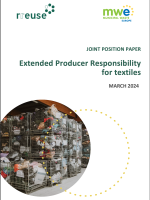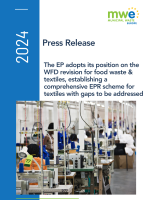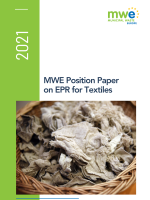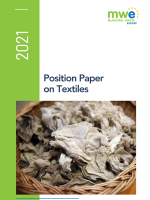EU Strategy on Plastics in a Circular Economy
Plastics form a key component of our 21st century economy and as a versatile material it will continue to play a pivotal role in the future EU and global economy through its use in various applications and products, ranging from aeronautics to health care and from automobile to food industry, to name but a few sectors.
There are, however, a number of key challenges related to the circularity of plastics in the entire value chain: high production of plastics creating large amounts of plastic waste and rise of CO2 emissions globally; ineffective collection of plastic waste causing land and marine litter; use of microplastics and single-use plastics being a key source of plastic waste leakage while at the same time causing severe damage to environment and health safety; use of diverse polymers and additives in plastic products not designed for recycling hindering plastics recycling thus maintaining landfilling and incineration rates of plastic waste high; low prices for fossil fuels-based virgin plastics keeping demand for recycled plastics low thus holding back investments in new recycling capacity and the creation of an EU market for secondary plastics.
These challenges lead us to recognise that the process to achieve the transition towards a circular economy for plastics consists of two phases:
- The current situation that would acknowledge that not all plastic packaging is recyclable today and aim at separating recyclable from non-recyclable, the latter going to energy from waste. (Phase A)
- The future aim that would prepare for a market with plastics designed for recycling, effectively collected, sorted and recycled into new resins, fit for purpose and in line with targets in the UN SDGs and EU Plastics Strategy. (Phase B)
Municipal Waste Europe welcomes the European Commission's new Plastics Strategy which is vital if the EU is to develop a sustainable, low-carbon, resource-efficient, competitive Circular Economy and below we set out our suggestions in each of the four pillars which, we, the European umbrella association representing public responsibility for waste, consider relevant to face the challenges in the transition to a circular economy for plastics:
1. Better plastics
- Plastics designed for recycling
Currently the daily entry into the waste stream of plastics made of a variety of plastic polymers with infinite combinations and variations and of non-recyclable plastics creates huge costs for their collection, sorting and recycling from municipalities. Therefore, polymer types and additives used in fast-moving consumer goods should be limited and all polymers used for such products should be designed - via industry-driven standards - for cost-effective sorting and recycling. At the same time, plastics containing environmentally harmful and hazardous substances as well as non-recyclable plastics should not be accepted on the EU market and clear rules should be set at EU level on the recyclability of plastics to ensure that only those plastics which are recyclable in a cost-effective manner will be put on the EU market. To this aim, eco-design criteria need to be established, for the eco-design of all plastic products, which are taken into account in the relevant EUlegislation such as the Packaging and Packaging Waste directive and the Eco-design directive. European funding, whether grants or loans or a combination thereof, should take great care to support innovation in eco-design to ensure the recyclability of the next generation of plastic products. A strict control scheme should be set up for the imported plastics to assure this. EPR schemes can play a role in promoting eco-design, with a modulation of fees based on the recycled content, and also on the level of recyclability of the product.
- Phasing out of microplastics and ban on oxo-degradable plastics
One key action needed to solve the severe problem of land and marine litter pollution is the complete phasing out of intentionally added microplastics. A significant body of evidence indicates that oxo-degradable plastics when they end up in land or aquatic environments degrade into harmful residues (including microplastics) within a period ranging from a few months to several years and thus, they pose a grave environmental risk, particularly in the marine environment as waterborne toxins adhere to their surface and are then ingested by fish, contaminating the food chain. Also, evidence to date suggests that oxo-degradable plastics go against the two core principles of the circular economy: designing out waste and pollution; and keeping products and materials in high-value use. Therefore, we support applying the precautionary principle by banning oxo-degradable plastics from the market, as stated in the letter we co-signed last year.
- Single-use plastics
Plastics in on-the-go and single use, disposable products have a very short lifespan, they have not effectively been integrated into separate collection systems for packaging waste and are therefore very difficult for municipalities to collect and treat. These difficulties, including the litter generated, cause high costs for municipalities. The multitude of polymers in these products also makes recycling difficult or impossible; they should therefore be limited to recyclable, monopolymer plastics. For plastic service packaging, which includes fast food containers and cutlery which is not recycled today, in most countries the producers pay into the EPR system therefore they should be included in the separate collection system which would give the waste stream access to communication, collection and treatment. Producers and retailers should be responsible for the negative impact of their product when it becomes litter, and at least finance the cost of collection and treatment of the littering of their waste.
- EU funding to move away from fossil-based plastics to bio-based plastics
In our aim to become a fossil-free society, European funding, whether grants or loans or a combination thereof, should take great care to support innovation in recycled plastics, bio-based plastics production and recycling of the existing fossil-based stock.
- Restriction of the use of biodegradable plastics
The current generation of biodegradable plastics is a source of confusion to consumers when it becomes a waste. It is not clear whether they should sort it as plastic or together with the bio-waste. The terminology is not clear either with frequent interchanging of 'biodegradable' and 'bio-based' when they are different products with different recyclability: one that is compostable and the other that is not. A clear definition of the differences would help. We propose that the use of biodegradable plastics in products should be limited to applications where the biodegradability has a very specific purpose, such as for the collection of bio-waste. Better, clearer standards for biodegradability are needed, including standards for compostability and digestibility which take into account common practice in European treatment facilities.
2. Better Collection
- Effective separate collection of packaging and non-packaging items
Prevention of plastic littering, both on land and at the marine environment, is essential and thus greater focus should be placed on collecting all existing packaging and non-packaging plastic products from the waste stream for recycling. Currently many EU Member States do not have collection and recycling schemes for non-packaging plastic waste. As a result, it often ends up in landfill as part of residual waste or even as marine litter. Focus should be put on plastics as a material and not as a packaging product. This requires good cooperation between municipalities and EPR schemes as well as national approaches to address plastics, which is not packaging, in dialogue with the producers/importers of these products. European funding, whether grants or loans or a combination thereof, should take great care to ensure that they are subsidising investments in effective collection methodologies. We also call for greater engagement of the producers in their own EPR schemes, to ensure coordination with municipalities and the success of the schemes they pay into, in achieving high collection rates of high quality waste materials.
- Harmonisation of DRS schemes
An increasing number of EU countries is implementing deposit return schemes because they contribute to high collection rates and quality recyclables. In this context, a harmonized approach for coordinating the new and existing EPR and DRS schemes for the same product type at EU level could be considered to tackle cross-border effects between member states and achieve increased collection rates of high-quality recyclates.
- Proper Collection systems
Collection systems should be designed for the optimal recovery of reusable and recyclable wastes and supported by the EPR systems. PAYT is one tool in that toolbox, however solutions must be tailored to the local situation. Funding for the exchange of best practice and mentoring as well as for innovation in collection systems would greatly advance the effectiveness of collection systems.
- Public awareness on waste collection and the prevention of littering
For the proper functioning of an effective collection system of all types of plastic waste, it is absolutely necessary for the local and regional authorities to consider public awareness on waste management. Information on the local sorting system should be communicated to householders and end-users at every opportunity. This can be achieved through a number of good practice measures such as: provision of marketing materials, organisation of awareness-raising (and/or communication) campaigns and training programmes, through online platforms, public engagement (e.g. roadshows or door-stepping), best practice sharing through exchange visits among citizens of neighbouring municipalities, professional municipal waste advisors educating pupils in schools and kindergartens. EPR budgets should include the provision of such communication tools and actions, as stipulated in the newly revised WFD.
3. Better processing for sorting and recycling into new products
- Better sorting and recycling techniques for all plastic items and industry standards
Although the number of recycling loops is currently low for most plastic polymers, new sorting and recycling procedures are being developed at a very rapid rate, including depolymerisation which would allow plastics to be recycled or indeed reassembled into new polymers indefinitely. In this context, the EU should support research and innovation for new sorting and recycling techniques, industry standards at the output of sorting phase for all types of plastics, and recycling infrastructure. European funding, whether grants or loans or a combination thereof, should also take great care to support investments in new sorting techniques for all plastic products (not only packaging), transformation of the less performing techniques as well as new recycling technologies.
- EU-wide energy recovery of plastics not suitable for recycling
Although landfilling of plastics should be banned by 2035, there are currently plastics containing environmentally harmful and hazardous substances, that are neither suited for re-use nor for recycling. Therefore, in order to implement Phase A, (acknowledge that not all plastic wastes are recyclable today and aim at separating recyclable from non-recyclable waste, the latter going to energy from waste), for the short term, it is preferable that unrecyclable plastic waste, is treated in Waste-to-Energy plants where the high energy content of plastic waste can be recovered. In the numerous European cases where landfills are uncovered, energy recovery rather than landfilling will also remove the possibility of these plastics becoming land and marine litter.
4. Uptake of products into an EU market for secondary plastics
- Use of minimum recycled content and limitation of additives
For the creation of an EU market for recycled plastics, Municipal Waste Europe supports the use of minimum recycled content as a requirement for new plastic products as a way of promoting recycling, reducing the use of fossil-based virgin plastics and curb the excessive quantity of CO2 emitted in their production. Therefore, by 2025 producers of plastic products should use a minimum of 50% of recyclate in the production of new plastics, increased to a 75% for all products by 2035. At the same time, harmonization and possibly limitation of additives used in plastics should be studied in order to further ease and simplify the recycling and application of recyclates.
- Green Public Procurement
Local and regional authorities should contribute to the improvement of plastics recycling through their public procurement policies. Therefore, they should set eco-design criteria for the purchase of products and services by demanding products made of fully recyclable plastics and products - up to a certain percentage - made of recycled content. In this way, local and regional authorities will avoid not only unnecessary use of plastics but also the use of non-recyclable plastics.
- Removal of subsidies for fossil-based virgin plastics
While subsidies still exist on fossil fuels rendering virgin plastics cheaper than recycled plastics, the latter will always be at a competitive disadvantage. This is a key economic barrier for the creation of an EU market for secondary plastics which needs to be removed. To promote the move to sustainable plastics, either subsidies on fossil fuels need to be removed or producers of non-recyclable products containing fossil fuels should pay for the mitigation of CO2 emissions from their energy recovery or incineration. This would help to level the playing field between the cost of primary and secondary resins.
- Voluntary pledges of the producers
Although the EU initiative of voluntary pledges can be a good example to stimulate industries to come forward with best practices, this should be considered as a good temporary measure and not a long-term solution for the low recyclability of plastics. Industry standards should also be set for recyclers to meet when they produce high-quality recyclable plastics. In this context, GPP and EU funding can become effective drivers - through the setup of effective green criteria for the purchase of and innovation in recyclable plastics or plastics with an increased recycled content - for the creation of an EU market for secondary plastics.
Thanking you in advance for your careful consideration of our proposals and looking forward to our further discussions.




